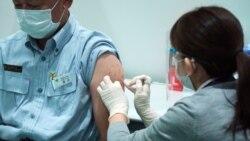The World Health Organization announced Friday that it had established and released the first standardized, clinical definition of what is commonly known as “long COVID,” to help boost treatment for sufferers.
Speaking virtually to reporters from the agency’s Geneva headquarters, WHO Head of Clinical Management Janet Diaz said the definition was agreed upon after global consultations with health officials.
She said the condition, in which symptoms of the illness persist well beyond what is commonly experienced, is usually referred to as “post-COVID,” among many similar iterations. It occurs in individuals who have had confirmed or probable new coronavirus infections, “usually three months on from the onset of the COVID-19, with symptoms that last for at least two months and cannot be explained by an alternative diagnosis.”
Those symptoms include “fatigue, shortness of breath, cognitive dysfunction,” she said, but there also are others, which generally have an adverse impact on everyday functioning. Diaz explained that until now, a lack of clarity among health care professionals about the condition has complicated efforts in advancing research and treatment.
Vaccine supply to Philippines
Meanwhile, a senior White House official announced Friday that the U.S. government was shipping 1,842,750 doses of the Pfizer COVID-19 vaccine to the Philippines — a donation that will be executed through the WHO-managed COVAX vaccine cooperative. The doses will arrive in two shipments, probably Sunday and Monday, according to the official.
The official said the Biden administration understands that ending the coronavirus pandemic requires eliminating it around the world.
U.S. drugmaker Moderna announced earlier Friday that it was planning to deliver another 1 billion doses of its COVID-19 vaccine to low-income countries next year. In a message posted to the company’s website, Moderna CEO Stéphane Bancel said the company was investing to expand its capacity to deliver the additional doses.
The disclosure was part of what Bancel described as his company’s five-pillar strategy to ensure low-income countries get access to the company’s vaccine. The plan includes not enforcing its vaccine patents, expanding its production capacity worldwide, and working with the United States and others to distribute their surplus doses of vaccine.
On Thursday, U.N. Secretary General António Guterres chastised the world’s wealthy nations for inequities in access to vaccines throughout the world.
Appearing virtually with WHO chief Tedros Adhanom Ghebreyesus, Guterres said, “Not to have equitable distribution of vaccines is not only a question of being immoral, it is also a question of being stupid.”
WHO's goals
The United Nations and the WHO are seeking $8 billion to implement their strategy to vaccinate 40 percent of every country’s population by the end of this year and 70 percent by mid-2022.
The Johns Hopkins Coronavirus Resource Center said Friday that it had recorded 237 million global COVID infections and nearly 5 million global deaths. The center said 6.4 billion vaccines had been administered.
Some information for this report came from The Associated Press, Reuters and Agence France-Presse.










